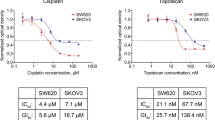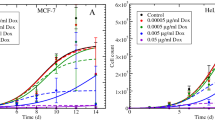Summary
Based on a pharmacokinetic model proposed by Jusko, which assumes that the cell killing action of cell cycle phase-non-specific agents occurs as a bimolecular reaction depending on drug concentration and cell density, we derived a cell kill kinetic equation for these drugs, including the decomposition constant in culture medium. This equation revealed that the cell killing activity of these drugs depends on the value of concentration x exposure time or the area under the drug concentration-time curve (AUC). It was also clarified that the curves for concentration-exposure time necessary for 90% cell kill on a log scale simulated on the basis of the equation differ according as whether drugs are stable or unstable in the culture medium, being expected to be linear with a slope of-1 in the former case, and to take the form of an asymptotic curve in the latter. For three cell cycle phase-non-specific agents, mitomycin C (MMC), 1-(4-amino-2-methylpyrimidine-5-yl)-methyl-3-(2-chloroethyl)3-nitrosourea hydrochloride (ACNU), and nitrogen mustard (HN2), we assessed the concentrations necessary for 90% cell kill (IC90) with various exposure times and the degradation rate constants under the culture conditions used. MMC was quite stable during the incubation, while ACNU and HN2 were unstable. When IC90's and exposure times were plotted on the above-mentioned graph, a linear relationship with a slope of-1 was seen for MMC, while for ACNU and HN2 the anticipated asymptotic curves resulted. We also ascertained that the decomposition constants for ACNU and HN2 expected on the basis of these curves showed a good agreement with the corresponding experimentally observed values. These results indicate that the cell killing action of cell cycle phase-non-specific drugs can be well described by a pharmacodynamic model and equation employing their decomposition constants and are dependent on the concentration-time product.
Similar content being viewed by others
References
Friedman OM, Boger E (1961) Colorimetric estimation of nitrogen mustard in aqueous media. Hydrolytic behavior of bis(beta-chloroethyl)amine, nor HN2. Anal Chem 33: 906
Jusko WJ (1971) Pharmacodynamics of chemotherapeutic effects: dose-time-response relationships for phase-nonspecific agents. J Pharm Sci 60: 892
Kennedy KA, Sligar SG, Polomski L, Sartorelli AC (1982) Metabolic activation of mitomycin C by liver microsomes and nuclei. Biochem Pharmacol 31: 2011
Levin VA (1986) Clinical anticancer pharmacology: some pharmacokinetic considerations. Cancer Treat Rev 13: 61
Mordenti J (1986) Dosage regimen design for pharmaceutical studies conducted in animals. J Pharm Sci 75: 852
Powis G (1985) Anticancer drug pharmacodynamics. Cancer Chemother Pharmacol 14: 177
Rupniak HT, Whelan RDH, Hill BT (1983) Concentration and time-dependent inter-relationships for antitumor drug cytotoxicities against tumor cells in vitro. Int J Cancer 32: 7
Shimoyama M (1975) Cytocidal action of anticancer agents: evaluation of the sensitivity of cultured animal and human cancer cells: In: Comparative leukemic research 1973, leukemogenesis. University of Tokyo Press, Tokyo/Karger, Basel, p 711
Shimoyama M, Kimura K (1972) Quantitative clonal growth of mammalian cells: its application for quantitative study of cytocidal action of mitomycin C. Gann 63: 773
Skipper HE, Schabel FM Jr, Mellett HH, Brockman RW (1970) Implications of biochemical, cytokinetic, pharmacologic, and toxicologic relationships in the design of optimal therapeutic schedules. Cancer Chemother Rep 54: 431
Weinkam RJ, Deen DF (1982) Quantitative dose-response relations for the cytotoxic activity of chloroethylnitrosoureas in cell culture. Cancer Res 42: 1008
Wheeler GP, Bowdon BJ, Grimsley JA, Leoyd HH (1974) Interrelationships of some chemical, physicochemical, and biological activities of several 1-(2-haloethyl)-1-nitrosoureas. Cancer Res 34: 194
Wu P-C, Ozols RF, Hatanaka M, Boone CW (1982) Anticancer drugs: effect on the cloning of Raji lymphoma cells in soft agar. JNCI 68: 115
Yamaoka K, Tanigawara Y, Nakagawa T, Uno T (1981) A pharmacokinetic analysis program (MULTI) for microcomputer. J Pharmacobiodyn 4: 879
Author information
Authors and Affiliations
Additional information
This study was supported in part by Grants-in-Aid for Cancer Research from the Ministry of Education, Science and Culture, and for New Drug Development Research from the Ministry of Health and Welfare, Japan
Rights and permissions
About this article
Cite this article
Ozawa, S., Sugiyama, Y., Mitsuhashi, Y. et al. Cell killing action of cell cycle phase-non-specific antitumor agents is dependent on concentration-time product. Cancer Chemother. Pharmacol. 21, 185–190 (1988). https://doi.org/10.1007/BF00262767
Received:
Accepted:
Issue Date:
DOI: https://doi.org/10.1007/BF00262767




